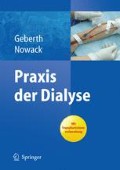Zusammenfassung
Der hohe extrakorporale Blutfluss der Hämodialyseverfahren bedarf eines speziellen Gefäßzugangs, der entweder arteriell gespeist wird oder auf die zentralen Venen zugreift. Das Blutflussangebot peripherer Venen erlaubt keine effiziente Dialyse. Großkalibrige zentrale Venen können passager oder permanent als Gefäßzugang genutzt werden, indem ein Katheter mit ausreichendem Lumen und Stabilität eingeführt wird.
Access this chapter
Tax calculation will be finalised at checkout
Purchases are for personal use only
Preview
Unable to display preview. Download preview PDF.
Literatur
Bansal R, Agarwal SK, Tiwari SC, Dash SC (2005) A prospective randomized study to compare ultrasound-guided with nonultrasound-guided double lumen internal jugular catheter insertion as a temporary hemodialysis access. Ren Fail 27(5):561–564
Betjes MGH, van Agteren M (2004) Prevention of dialysis catheter-related sepsis with a citrate-taurolidine-containing lock solution. Nephrol Dial Transplant
Blot F, Schmidt E et al. (1998) Earlier positivity of central venous versus peripheral blood cultures is highly predictive of catheter related sepsis. J Clin Microbiol 36: 105–109
Boelaert JR, Van Landyt HW, Godard CA et al. (1993) Nasal mupirocin ointment decreases the incidence of Staphylococcus aureus bacteremia in hemodialysis patients. Nephrol Dial Transplant 8: 235–239
DesJardin JA, Falagas ME, Ruthazer R, Griffith J, Wawrose D, Schenkein D, Miller K, Snydman DR (1999) Clinical utility of blood cultures drawn from indwelling central venous catheters in hospitalized patients with cancer. Ann Intern Med. Nov 2;131(9):641–647
Haire WD, Deitcher SR, Mullane KM et al. (2004) Recombinant urokinase for restoration of patency in occluded central venous access devices. A double-blind, placebo-controlled trial. Thromb Haemost. Sep;92(3):575–582
Hepp W, Koch M, Konner K (2008) Dialyseshunts. 2. Auflage, Steinkopff
Hollenbeck M, Graur C (2009) Stellenwert der Sonographie bei der Entscheidungsfindung des Dialysezugangs und bei der Diagnostik der Shuntdysfunktion. Der Nephrologe 1: 42–52
Hollenbeck M, Mickley V et al. (2009) Gefäßzugang zur Hämodialyse. Interdisziplinäre Empfehlungen deutscher Fachgesellschaften. Der Nephrologe 4: 158–176
Jaffer Y, Selby NM, Taal MW, Fluck RJ, McIntyre CW (2008) A meta-anlysis of hemodialysis catheter locking solutions in the prevention of catheter-related infection. Am J Kidney Dis. Feb;51(2):233–241
Levy J et al. (2007) Oxford Handbook of Dialysis, 2nd edition, Oxford
Marr KA et al. (1997) Catheter-related bacteremia and outcome of attempted catheter salvage in patients undergoing hemodialysis. Ann Intern Med 127: 275–280
Mermel LA, Farr BM et al. (2001) Guidelines for the management of intravascular catheter-related infections. Clin Infect Dis 2001 May 1;32(9):1249–1272. Epub Apr 3
Mickley V (2003) Gefäßzugang für Akutdialysen. Intensivmed 40: 247–255.e 2. 2009: 158–176
Provonost P, Needham D, Berenholtz S et al. (2006) An intervention to decrease catheter-related bloodstream infections in the ICU. N Engl J Med Dec 28;355(26):2725–2732
Savader SJ, Ehrman KO, Porter DJ, Haikal LC, Oteham AC (2001) Treatment of hemodialysis catheter-associated fibrin sheaths by rt-PA infusion: critical analysis of 124 procedures. J Vasc Interv Radiol. Jun;12(6):711–715
Savage MT, Ferro CJ, Sassano A, Tomson CR (2002) The impact of arteriovenous fistula formation on central hemodynamci pressures in chronic renal failure patients: a prospective study. Am J Kidney Dis. Oct;40(4):753–759
Schuman E, Ronfeld A, Barclay C, Heinl P (2007) Comparison of clinical assessment with ultrasound flow for hemodialysis access surveillance. Arch Surg. 142(12): 1129–1133
Shaldon S, Chiandussi L, Higgs B (1961) Hemo-dialysis by percutaneous catheterization of the femoral artery and vein with regional heparinization. Lancet 2:857
Shanks RM et al. (2006) Catheter lock solutions influence staphylococcal biofilm formation on abiotic surfaces. Nephrol Dial Transplant 21: 2247–2255
Silva MB Jr, Hobson RW 2nd, Pappas PJ, Jamil Z, Araki CT, Goldberg MC, Gwertzman G, Padberg FT Jr. (1998) A strategy for increasing use of autogenous hemodialyis access procedures: impact of preoperative non-invasive evaluation. J Vasc Surg. Feb;27(2):302–307; discussion 307–308
Tokars JL, Miller ER, Stein G (2002) New national surveillance system for hemodialysis-associated infections: initial results. Am J Infect Control Aug;30(5):288–295
Trerotola SO et al. (1998) Tunneled hemodialysis catheters: use of silver-coated catheter for prevention of infection – a randomized study. Radiology 207: 491–496
Weijmer MC et al. (2005) Randomized clinical trial comparison of trisodium citrate 30% and heparin as catheterlocking solution in hemodialysis patients. J Am Soc Nephrol 16: 2769–2777
Winnett G et al. (2008) Trisodium citrate 46,7% selectively and safely reduces staphylococcal catheter-related bacteraemia. Nephrol Dial Transplant 23: 3592–9835
Author information
Authors and Affiliations
Rights and permissions
Copyright information
© 2011 Springer-Verlag Berlin Heidelberg
About this chapter
Cite this chapter
Geberth, S., Nowack, R. (2011). Gefäßzugang zur Hämodialyse (HD). In: Praxis der Dialyse. Springer, Berlin, Heidelberg. https://doi.org/10.1007/978-3-642-13099-1_3
Download citation
DOI: https://doi.org/10.1007/978-3-642-13099-1_3
Publisher Name: Springer, Berlin, Heidelberg
Print ISBN: 978-3-642-13098-4
Online ISBN: 978-3-642-13099-1
eBook Packages: Medicine (German Language)

